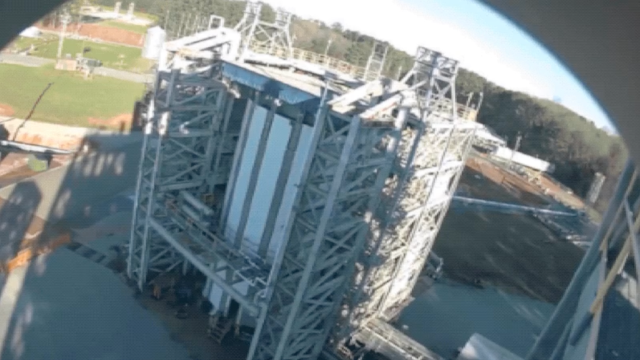A highly-anticipated heavy-lift rocket was getting prepped for its inaugural flight when a spark triggered a fiery explosion at NASA’s Alabama launch facility, potentially threatening next month’s rocket debut.
On Thursday, United Launch Alliance chief executive Tory Bruno shared a closer look at the explosion that took place on March 29 at the test stand at NASA’s Marshall Space Flight Centre in Alabama. “[Hydrogen] accumulated inside the stand. Found an ignition source. Burned fast,” Bruno tersely wrote on Twitter. “Over pressure caved in our forward dome and damaged the rig.”
Outside of the test rig/ stand. Test article is inside (you can’t see it). Hydrogen leak. H2 accumulated inside the rig. Found an ignition source. Burned fast. Over pressure caved in our forward dome and damaged the rig. pic.twitter.com/0d0KpI1ggj
— Tory Bruno (@torybruno) April 13, 2023
ULA had been pressurizing the upper stage of the Vulcan rocket when the anomaly occurred. A spark ignited a significant accumulation of hydrogen fuel, causing a massive fireball to sweep over the test rig. “This is why we thoroughly & rigorously exercise every possible condition on the ground before flight. Investigation is underway,” Bruno wrote on Twitter after the explosion. “Vulcan will fly when complete.”
ULA’s two-stage Vulcan Centaur rocket has been in development since 2014 and its debut was finally scheduled on May 4 following several delays. The Colorado-based company had originally hoped to launch Vulcan in 2020 and then again in 2022 before deciding it was ready to fly next month. ULA was waiting on the delivery of two BE-4 engines built by Jeff Bezos’ Blue Origin, which came more than four years late.
Following the unfortunate anomaly, however, it’s not clear when Vulcan will get to fly. ULA will get access to the first stage on Friday, recovering it for analysis, according to ULA’s Bruno. “Don’t know yet whether the leak was in the test article or the test rig,” he wrote on Twitter. By “test article,” Bruno is referring to the rocket.
The fully expendable 61.57 m-tall rocket is set to replace ULA’s Atlas V and Delta IV rockets, which have been in use for the past two decades. The Vulcan Centaur is designed to lift 27,216 kg to low Earth orbit and 6,486 kg to geosynchronous orbit (by comparison, SpaceX’s Falcon 9 can carry 22.8 metric tons to LEO.)
ULA was counting on the success of its first mission in order to schedule in another Vulcan launch later this year for Sierra Space’s Dream Chaser mission. The company needs to complete two Vulcan flights in order to get certified to launch U.S. military and intelligence satellites for the Space Force. ULA is under contract to deliver 35 missions for the U.S. Space Force in the next five years. Vulcan is also booked to launch more satellites for Amazon’s Kuiper satellite project.
For its inaugural mission, the rocket is set to deliver Astrobotic’s Peregrine lunar lander, which, on behalf of NASA, will attempt to deliver 11 payloads to the lunar surface. Vulcan will also attempt to deliver the first two Amazon Kuiper internet satellites to low Earth orbit, which are owned by Blue Origin’s Bezos. So yeah, ULA needs this rocket off the ground, and sooner rather than later.
During his back and forth with Twitter users, Bruno reassured his followers that the massive fireball wasn’t as bad as it looked, and that only time will tell whether Vulcan’s upper stage will be fit for liftoff.
